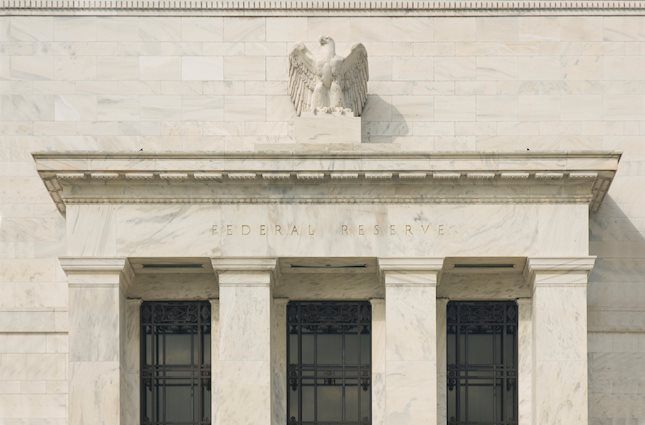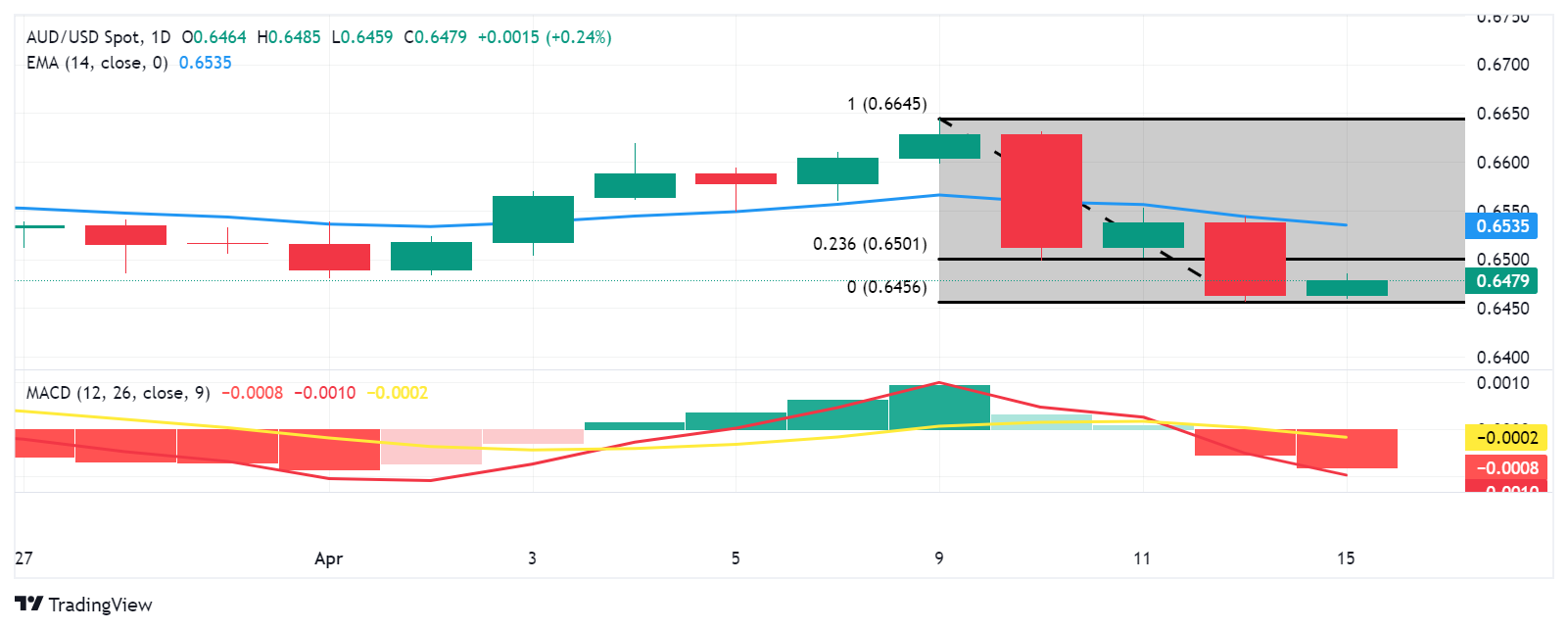- Australian Dollar gains ground amid escalated geopolitical tensions in the Middle East.
- Australian currency could face challenges following the lower ASX 200 Index.
- US Dollar receives support as traders express concerns about a potential reaction from Israel following Iran's attack.
The Australian Dollar (AUD) rebounds on Monday from the eight-week low of 0.6456 reached last Friday. However, the AUD/USD pair encountered obstacles as traders sought refuge in the US Dollar (USD) amidst heightened tensions in the Middle East.
The Australian Dollar may encounter further challenges as the ASX 200 Index declined, reflecting investor concerns about a possible retaliatory response from Israel to Iran's attack on Saturday. Iran deployed explosive drones and missiles targeting military sites in Israel, with Israel reportedly intercepting nearly all of the incoming projectiles, as per Reuters.
The US Dollar Index (DXY) edges lower following the subdued US Treasury yields despite the hawkish sentiment surrounding the Federal Reserve’s (Fed) monetary policy outlook. Strong US inflation and positive macroeconomic indicators are causing the Fed to reassess its stance on monetary easing. Market participants are expected to closely watch the US Retail Sales figures due to be released on Monday, along with Fedspeak.
Daily Digest Market Movers: Australian Dollar rebounds amid a hawkish sentiment surrounding Fed
- Australia’s Consumer Inflation Expectations released on Thursday, showed an increase of 4.6% in April against the previous increase of 4.3%.
- Australian labor market data is due on Thursday, including seasonally adjusted Employment Change and Unemployment Rate for March.
- As anticipated, the People's Bank of China (PBoC) maintained the 1-year medium-term lending facility (MLF) interest rate at 2.5%. The PBoC injected 100 billion Yuan through a one-year MLF operation, resulting in a net drain of 70 billion Yuan.
- Chinese Gross Domestic Product (GDP) and Industrial Production data are scheduled to be released on Tuesday.
- Boston Federal Reserve (Fed) President Susan Collins stated on Friday that she foresees 'approximately two' rate cuts for 2024, while also expecting inflationary pressures to ease later in the year. She emphasized that while a rate hike is not currently included in the baseline scenario, it cannot be completely discounted.
- According to the CME FedWatch Tool, the likelihood of interest rates remaining unchanged in the June meeting has been increased to 63.5% from the previous week of 46.8%.
- US Michigan Consumer Sentiment Index decreased to 77.9 in April, from the previous reading of 79.4 and the market expectation of 79.0, report released by the University of Michigan on Friday.
- Core US Producer Price Index (PPI) report showed on Thursday, an increase of 2.4% YoY in March. The market was expecting a rise to 2.3% from 2.1% prior.
Technical Analysis: Australian Dollar remains above 0.6450; next barrier at 23.6% Fibo level
The Australian Dollar trades around 0.6480 on Monday. Technical analysis suggests a bearish sentiment for the AUD/USD pair as the Moving Average Convergence Divergence (MACD) is positioned below the centerline and shows a divergence below the signal line. Key support appears at the major level of 0.6450. A break below this level could prompt the pair to navigate the region around the psychological level of 0.6400. On the upside, the AUD/USD pair could find resistance around the psychological level of 0.6500, aligned with the 23.6% Fibonacci retracement level of 0.6501. A breakthrough above the latter could lead the pair to test the 14-day Exponential Moving Average (EMA) at 0.6535, followed by the major barrier at 0.6550.
AUD/USD: Daily Chart
Australian Dollar price today
The table below shows the percentage change of Australian Dollar (AUD) against listed major currencies today. Australian Dollar was the strongest against the .
| USD | EUR | GBP | CAD | AUD | JPY | NZD | CHF | |
| USD | 0.00% | 0.05% | 0.02% | -0.11% | 0.35% | 0.01% | 0.07% | |
| EUR | 0.01% | 0.05% | 0.03% | -0.09% | 0.36% | 0.02% | 0.08% | |
| GBP | -0.05% | -0.06% | -0.03% | -0.16% | 0.30% | -0.04% | 0.01% | |
| CAD | -0.02% | -0.03% | 0.02% | -0.12% | 0.33% | -0.01% | 0.05% | |
| AUD | 0.10% | 0.09% | 0.14% | 0.13% | 0.45% | 0.12% | 0.17% | |
| JPY | -0.33% | -0.35% | -0.28% | -0.34% | -0.46% | -0.32% | -0.27% | |
| NZD | -0.01% | -0.03% | 0.02% | 0.00% | -0.10% | 0.33% | 0.05% | |
| CHF | -0.07% | -0.08% | -0.02% | -0.05% | -0.17% | 0.28% | -0.05% |
The heat map shows percentage changes of major currencies against each other. The base currency is picked from the left column, while the quote currency is picked from the top row. For example, if you pick the Euro from the left column and move along the horizontal line to the Japanese Yen, the percentage change displayed in the box will represent EUR (base)/JPY (quote).
Australian Dollar FAQs
One of the most significant factors for the Australian Dollar (AUD) is the level of interest rates set by the Reserve Bank of Australia (RBA). Because Australia is a resource-rich country another key driver is the price of its biggest export, Iron Ore. The health of the Chinese economy, its largest trading partner, is a factor, as well as inflation in Australia, its growth rate and Trade Balance. Market sentiment – whether investors are taking on more risky assets (risk-on) or seeking safe-havens (risk-off) – is also a factor, with risk-on positive for AUD.
The Reserve Bank of Australia (RBA) influences the Australian Dollar (AUD) by setting the level of interest rates that Australian banks can lend to each other. This influences the level of interest rates in the economy as a whole. The main goal of the RBA is to maintain a stable inflation rate of 2-3% by adjusting interest rates up or down. Relatively high interest rates compared to other major central banks support the AUD, and the opposite for relatively low. The RBA can also use quantitative easing and tightening to influence credit conditions, with the former AUD-negative and the latter AUD-positive.
China is Australia’s largest trading partner so the health of the Chinese economy is a major influence on the value of the Australian Dollar (AUD). When the Chinese economy is doing well it purchases more raw materials, goods and services from Australia, lifting demand for the AUD, and pushing up its value. The opposite is the case when the Chinese economy is not growing as fast as expected. Positive or negative surprises in Chinese growth data, therefore, often have a direct impact on the Australian Dollar and its pairs.
Iron Ore is Australia’s largest export, accounting for $118 billion a year according to data from 2021, with China as its primary destination. The price of Iron Ore, therefore, can be a driver of the Australian Dollar. Generally, if the price of Iron Ore rises, AUD also goes up, as aggregate demand for the currency increases. The opposite is the case if the price of Iron Ore falls. Higher Iron Ore prices also tend to result in a greater likelihood of a positive Trade Balance for Australia, which is also positive of the AUD.
The Trade Balance, which is the difference between what a country earns from its exports versus what it pays for its imports, is another factor that can influence the value of the Australian Dollar. If Australia produces highly sought after exports, then its currency will gain in value purely from the surplus demand created from foreign buyers seeking to purchase its exports versus what it spends to purchase imports. Therefore, a positive net Trade Balance strengthens the AUD, with the opposite effect if the Trade Balance is negative.
Information on these pages contains forward-looking statements that involve risks and uncertainties. Markets and instruments profiled on this page are for informational purposes only and should not in any way come across as a recommendation to buy or sell in these assets. You should do your own thorough research before making any investment decisions. FXStreet does not in any way guarantee that this information is free from mistakes, errors, or material misstatements. It also does not guarantee that this information is of a timely nature. Investing in Open Markets involves a great deal of risk, including the loss of all or a portion of your investment, as well as emotional distress. All risks, losses and costs associated with investing, including total loss of principal, are your responsibility. The views and opinions expressed in this article are those of the authors and do not necessarily reflect the official policy or position of FXStreet nor its advertisers. The author will not be held responsible for information that is found at the end of links posted on this page.
If not otherwise explicitly mentioned in the body of the article, at the time of writing, the author has no position in any stock mentioned in this article and no business relationship with any company mentioned. The author has not received compensation for writing this article, other than from FXStreet.
FXStreet and the author do not provide personalized recommendations. The author makes no representations as to the accuracy, completeness, or suitability of this information. FXStreet and the author will not be liable for any errors, omissions or any losses, injuries or damages arising from this information and its display or use. Errors and omissions excepted.
The author and FXStreet are not registered investment advisors and nothing in this article is intended to be investment advice.
Recommended content
Editors’ Picks

AUD/USD remains vulnerable near multi-month low after Aussie data
AUD/USD reacts little to better-than-expected Australian Goods Trade Balance data and hangs near a multi-month low touched on Wednesday amid rising bets for an early RBA rate cut. Furthermore, China's economic woes, US-China trade war fears and geopolitical risk undermine the risk-sensitive Aussie.

USD/JPY retreats further from the weekly top, slides below mid-150.00s
USD/JPY struggles to build on the previous day's strong move up to the weekly top and trades with a mild negative bias during the Asian session on Thursday. Bets for a December BoJ rate hike and the overnight sharp fall in the US bond yields lend some support to the lower-yielding JPY.

Gold price lacks firm near-term direction and is stuck in a familiar range
Gold price extends its sideways consolidative price move in a familiar range, awaiting a fresh catalyst before the next leg of a directional move. Geopolitical tensions, trade war fears and the overnight decline in the US bond yields offer support to the safe-haven XAU/USD.

Ripple's XRP could see a price rebound despite retail activity decline, RLUSD launch delay
XRP traded near $2.4 on Wednesday as Ripple Labs clarified that its RLUSD stablecoin will not debut on exchanges despite a rumored launch among crypto community members. Amid a sharp decline in XRP's price, on-chain data shows the remittance-based token still has the potential to resume its rally.

Four out of G10
In most cases, the G10 central bank stories for December are starting to converge on a single outcome. Here is the state of play: Fed: My interpretation of Waller’s speech this week is that his prior probability for a December cut was around 75% before the data.

Best Forex Brokers with Low Spreads
VERIFIED Low spreads are crucial for reducing trading costs. Explore top Forex brokers offering competitive spreads and high leverage. Compare options for EUR/USD, GBP/USD, USD/JPY, and Gold.
